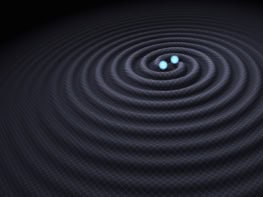
By James Dacey
Don’t worry, the aliens haven’t landed. The people in this photo are watching with excitement shortly before this giant electromagnet completed its 5000 km journey on Friday to arrive at Fermi National Accelerator Laboratory just outside Chicago. The 15 m-wide ring that weighs more than 15,000 kg has been travelling for the past five weeks by land and sea from its previous home on Long Island in New York State.
The giant electromagnet has served as part of the Muon g-2 experiment at Brookhaven National Laboratory. This experiment – to describe it crudely – is designed to measure how muons wobble in a magnetic field, as many believe this will provide clues to new physics beyond the Standard Model. This experiment is now relocating to Fermilab, which offers a more intense and pure beam of muons than the Brookhaven lab.
After cost analysis, the Muon g-2 team realized it would be far cheaper to reuse the same magnet, rather than building another one or attempting to upgrade the Muon beamline at Brookhaven. Having taken that decision, the team was then faced with an incredibly complicated exercise in logistics and careful handling.
The g-2 magnet is large, unwieldy and fragile so it couldn’t just be stuck on the back of any old lorry and driven down the freeway during busy periods. Instead the collaboration hired the services of Emmert International, a company that specializes in heavy haul transportation and rigging services. After a year of consultation the two parties agreed on a route that saw the magnet travel largely by water rather than road. It sailed down the US east coast and around Florida before travelling up through various waterways including the Mississippi river, on an epic journey that you can read about in this article in Symmetry Magazine.
The experiment will start taking data in 2016. It gets its name from the fact that the gyromagnetic ratio “g” of the muon differs ever so slightly — by about 0.1% — from the simple expectation of 2 as predicted by the Standard Model. Measuring g-2 with high precision and comparing its value to the theoretical prediction could allow researchers to compare the data with theories that predict undiscovered subatomic particles that exist in nature.



